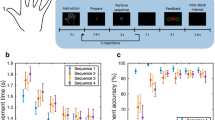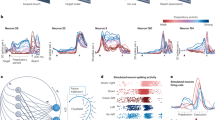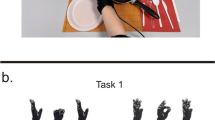Abstract
Rhythmic movements, such as walking, chewing or scratching, are phylogenetically old motor behaviors found in many organisms, ranging from insects to primates. In contrast, discrete movements, such as reaching, grasping or kicking, are behaviors that have reached sophistication primarily in younger species, particularly primates. Neurophysiological and computational research on arm motor control has focused almost exclusively on discrete movements, essentially assuming similar neural circuitry for rhythmic tasks. In contrast, many behavioral studies have focused on rhythmic models, subsuming discrete movement as a special case. Here, using a human functional neuroimaging experiment, we show that in addition to areas activated in rhythmic movement, discrete movement involves several higher cortical planning areas, even when both movement conditions are confined to the same single wrist joint. These results provide neuroscientific evidence that rhythmic arm movement cannot be part of a more general discrete movement system and may require separate neurophysiological and theoretical treatment.
This is a preview of subscription content, access via your institution
Access options
Subscribe to this journal
Receive 12 print issues and online access
$209.00 per year
only $17.42 per issue
Buy this article
- Purchase on Springer Link
- Instant access to full article PDF
Prices may be subject to local taxes which are calculated during checkout



Similar content being viewed by others
References
Marder, E. Motor pattern generation. Curr. Opin. Neurobiol. 10, 691–698. (2000).
Lamb, T. & Yang, J.F. Could different directions of infant stepping be controlled by the same locomotor central pattern generator? J. Neurophysiol. 83, 2814–2824. (2000).
Pinter, M.M. & Dimitrijevic, M.R. Gait after spinal cord injury and the central pattern generator for locomotion. Spinal Cord 37, 531–537 (1999).
Dimitrijevic, M.R., Gerasimenko, Y. & Pinter, M.M. Evidence for a spinal central pattern generator in humans. Ann. N. Y. Acad. Sci. 860, 360–376 (1998).
Kelso, J.A.S. Dynamic Patterns: The Self-Organization of Brain and Behavior (MIT Press, Cambridge, Massachusetts, USA, 1995).
Turvey, M.T. Coordination. Am. Psychol. 45, 938–953 (1990).
Kugler, P.N. & Turvey, M.T. Information, Natural Law, and the Self-Assembly of Rhythmic Movement (Erlbaum, Hillsdale, New Jersey, USA, 1987).
Andersen, R.A., Snyder, L.H., Bradley, D.C. & Xing, J. Multimodal representation of space in the posterior parietal cortex and its use in planning movements. Annu. Rev. Neurosci. 20, 303–330 (1997).
Kalaska, J.F., Scott, S.H., Cisek, P. & Sergio, L.E. Cortical control of reaching movements. Curr. Opin. Neurobiol. 7, 849–859 (1997).
Sabes, P.N. The planning and control of reaching movements. Curr. Opin. Neurobiol. 10, 740–746 (2000).
Flash, T. & Sejnowski, T. Computational approaches to motor control. Curr. Opin. Neurobiol. 11, 655–662 (2001).
Morasso, P. Spatial control of arm movements. Exp. Brain Res. 42, 223–227 (1981).
Abend, W., Bizzi, E. & Morasso, P. Human arm trajectory formation. Brain 105, 331–348 (1982).
Flash, T. & Hogan, N. The coordination of arm movements: An experimentally confirmed mathematical model. J. Neurosci. 5, 1688–1703 (1985).
Uno, Y., Kawato, M. & Suzuki, R. Formation and control of optimal trajectory in human multijoint arm movement — Minimum torque-change model. Biol. Cybern. 61, 89–101 (1989).
Kawato, M. Internal models for motor control and trajectory planning. Curr. Opin. Neurobiol. 9, 718–727 (1999).
Feldman, A.G. Superposition of motor programs. I. Rhythmic forearm movements in man. Neuroscience 5, 81–90 (1980).
Latash, M.L. Control of Human Movement (Human Kinetics, Champaign, Illinois, USA, 1993).
Soechting, J.F. & Terzuolo, C.A. Organization of arm movements in three dimensional space. Wrist motion is piecewise planar. Neuroscience 23, 53–61 (1987).
Sternad, D. & Schaal, D. Segmentation of endpoint trajectories does not imply segmented control. Exp. Brain Res. 124, 118–136 (1999).
Schaal, S. & Sternad, D. Origins and violations of the 2/3 power law in rhythmic 3D movements. Exp. Brain Res. 136, 60–72 (2001).
Richardson, M.J. & Flash, T. Comparing smooth arm movements with the two-thirds power law and the related segmented-control hypothesis. J. Neurosci. 22, 8201–8211 (2002).
Sternad, D., Dean, W.J. & Schaal, S. Interaction of rhythmic and discrete pattern generators in single joint movements. Hum. Mov. Sci. 19, 627–665 (2000).
Sternad, D., De Rugy, A., Pataky, T. & Dean, W.J. Interaction of discrete and rhythmic movements over a wide range of periods. Exp. Brain Res. 147, 162–174 (2002).
Wei, K., Wertman, G. & Sternad, D. Interactions between rhythmic and discrete components in a bimanual task. Motor Control 7, 134–155 (2003).
Smits-Engelsman, B.C., Van Galen, G.P. & Duysens, J. The breakdown of Fitts' law in rapid, reciprocal aiming movements. Exp. Brain Res. 145, 222–230 (2002).
Ijspeert, A., Nakanishi, J. & Schaal, S. in Advances in Neural Information Processing Systems 15 (eds. Becker, S., Thrun, S. & Obermayer, K.) 1547–1554 (MIT Press, Cambridge, Massachusetts, USA, 2003).
de Rugy, A. & Sternad, D. Interaction between discrete and rhythmic movements: reaction time and phase of discrete movement initiation during oscillatory movements. Brain Res. 994, 160–174 (2003).
Sternad, D. & Dean, W.J. Rhythmic and discrete elements in multi-joint coordination. Brain Res. 989, 152–171 (2003).
Picard, N. & Strick, P.L. Imaging the premotor areas. Curr. Opin. Neurobiol. 11, 663–672 (2001).
Seitz, R.J., Stephan, K.M. & Binkofski, F. Control of action as mediated by the human frontal lobe. Exp. Brain Res. 133, 71–80 (2000).
Gordon, A.M., Lee, J.H., Flament, D., Ugurbil, K. & Ebner, T.J. Functional magnetic resonance imaging of motor, sensory, and posterior parietal cortical areas during performance of sequential typing movements. Exp. Brain Res. 121, 153–166 (1998).
Debaere, F. et al. Brain areas involved in interlimb coordination: a distributed network. Neuroimage 14, 947–958 (2001).
Rizzolatti, G. & Arbib, M.A. Language within our grasp. Trends Neurosci. 21, 188–194 (1998).
Kertzman, C., Schwarz, U., Zeffiro, T.A. & Hallett, M. The role of posterior parietal cortex in visually guided reaching movements in humans. Exp. Brain Res. 114, 170–183 (1997).
Grafton, S.T., Fagg, A.H., Woods, R.P. & Arbib, M.A. Functional anatomy of pointing and grasping in humans. Cereb. Cortex 6, 226–237 (1996).
Fink, G.R., Frackowiak, R.S., Pietrzyk, U. & Passingham, R.E. Multiple nonprimary motor areas in the human cortex. J. Neurophysiol. 77, 2164–2174 (1997).
Deiber, M.P., Honda, M., Ibanez, V., Sadato, N. & Hallett, M. Mesial motor areas in self-initiated versus externally triggered movements examined with fMRI: effect of movement type and rate. J. Neurophysiol. 81, 3065–3077 (1999).
Thickbroom, G.W. et al. Differences in functional magnetic resonance imaging of sensorimotor cortex during static and dynamic finger flexion. Exp. Brain Res. 126, 431–438 (1999).
Lewis, P.A. & Miall, R.C. Distinct systems for automatic and cognitively controlled time measurement: evidence from neuroimaging. Curr. Opin. Neurobiol. 13, 250–255 (2003).
Brown, T.G. On the nature of the fundamental activity of the nervous centres; together with an analysis of rhythmic activity in progression, and a theory of the evolution of function in the nervous system. J. Physiol. (Lond.) 48, 18–46 (1914).
Turner, R., Howseman, A., Rees, G.E., Josephs, O. & Friston, K. Functional magnetic resonance imaging of the human brain: data acquisition and analysis. Exp. Brain Res. 123, 5–12 (1998).
Talairach, J. & Tournoux, P. Co-Planar Stereotaxic Atlas of the Human Brain: 3-Dimensional Proportional System: An Approach to Cerebral Imaging (Thieme, Stuttgard, Germany, 1988).
Brett, M., Christiff, K., Cusack, R. & Lancaster, J. Using the Talairach atlas with the MNI template. Neuroimage 13, S85 (2001).
Friston, K.J., Frith, C.D., Liddle, P.F. & Frackowiak, R.S.J. Comparing functional (PET) images: the assessment of significant change. J. Cereb. Blood Flow Metab. 11, 690–699 (1991).
Brett, M., Anton, J.-L., Valabregue, R. & Poline, J.-B. in 8th International Conference on Funcational Mapping of the Human Brain (Sendai, Japan, 2002).
Acknowledgements
This research was supported in part by US National Science Foundation grants ECS-0325383, IIS-0312802, IIS-0082995, ECS-0326095 and ANI-0224419, the ERATO Kawato Dynamic Brain Project funded by the Japanese Science and Technology Agency, and the National Institute of Information and Communications Technology (NICT).
Author information
Authors and Affiliations
Corresponding author
Ethics declarations
Competing interests
The authors declare no competing financial interests.
Rights and permissions
About this article
Cite this article
Schaal, S., Sternad, D., Osu, R. et al. Rhythmic arm movement is not discrete. Nat Neurosci 7, 1136–1143 (2004). https://doi.org/10.1038/nn1322
Received:
Accepted:
Published:
Issue Date:
DOI: https://doi.org/10.1038/nn1322
This article is cited by
-
Biomarkers for rhythmic and discrete dynamic primitives in locomotion
Scientific Reports (2022)
-
A general procedure to measure the pacing of body movements timed to music and metronome in younger and older adults
Scientific Reports (2021)
-
Cortical sensorimotor activity in the execution and suppression of discrete and rhythmic movements
Scientific Reports (2021)
-
Performance of discrete, reciprocal, and cyclic movements of the ipsilesional upper limb in individuals after stroke
Experimental Brain Research (2020)
-
Synergies reciprocally relate end-effector and joint-angles in rhythmic pointing movements
Scientific Reports (2019)



